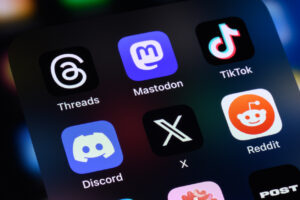The Scoop: Google changed plans to kill tracking cookies. Here’s what it means.
Plus: Kamala Harris deepfakes rack up millions of views; Wall Street AI bubble could be set to pop.

For the past four years, marketers have been preparing for a cookie-pocalypse, if you will. Google said it would slowly end the use of the popular bits of tracking code that advertisers use to follow users across the web.
Marketers spent years figuring out their next plans. But now, Google is changing course. Cookies won’t be eliminated entirely, according to the Wall Street Journal, but consumers will be given a choice to keep the cookies in place or opt out.
The impact of this change depends on how exactly the Google Chrome browser phrases that prompt to its more than 3 billion users. When Apple introduced a similar opt-in, opt-out system for app tracking, it turned the digital advertising space on its head. While specific numbers aren’t available for how many opted out of tracking, Vox reported it’s believed “the majority” did so, in response to a prompt that said, “Allow (app name) to track your activity across other companies’ websites and apps? By selecting ‘Allow,’ (the app) may reduce the ads you find irrelevant or repetitive over time.”
If large numbers of users do opt out, then Google’s Privacy Sandbox, the set of tools it’s developed to replace cookies, could become highly relevant.
“We don’t have the details and regulators may have a say in this. If we see the type of opting out we have seen with [Apple’s App Tracking Transparency], Privacy Sandbox and other cookieless options will be important tools,” Jason Hartley, head of media innovation at PMG, told the Wall Street Journal. “If not, advertisers will have to decide if cookies are right for them based on their goals, brand values, etc.”
Why it matters: When advertising takes a hit or undergoes a major change, that presents an opportunity for public relations.
No, the two aren’t the same and don’t fulfill the same role in the sales funnel. But if the Google ads that have dominated the internet for the past decade become less effective, there could be more dollars and options available for savvy public relations practitioners. Pros must make the case for how they can build awareness and affinity with users, driving many of those same touchpoints that advertising might have in the past.
The key is finding ways to more tightly connect public relations with a final sale. Depending on what area you’re practicing in, that might be easier than others: it’s simple to include a call-to-action in a social media video, but much harder to persuade a journalist to do so in an article.
Still, this is a moment for PR practitioners to seize. Find the gaps opened up by these changes and pursue new ways to make your way in.
Editor’s Top Reads:
- In an unsurprising yet still concerning turn of events, a viral deepfake of Vice President Kamala Harris have exploded since President Joe Biden announced he would step aside and she became the presumptive Democratic candidate. The clip, which combines real footage of Harris speaking at her alma mater, Howard University, with fabricated audio of her slurring her words and speaking nonsensical phrases, like “Today is today and yesterday was today yesterday. Tomorrow will be today tomorrow. So, live today so the future today will be as the past today, as it is tomorrow,” Mashable reported. The video has been removed from TikTok, since it violates the app’s misinformation rules, but not before it gained more than 4 million views. On X, however, deepfakes are not against the rules, and it’s received more than 3 million views, albeit with a Community Note now appended noting it’s a fake. If bad actors can create deepfakes of the vice president of the United States, any major executive, celebrity or stakeholder is at risk. Know where to go to get fakes removed (or how to add Community Notes) and be ready to fight back.
- Big Tech is pumping billions upon billions of dollars into inventing cutting-edge AI tools. Investors are starting to wonder when that will pay off in profits. The Washington Post reported that analysts and investors are starting to ask pointed questions about when Microsoft, Meta and other platforms would begin to see the fruits of their labor of going all-in on AI. And of course, thousands of startups have sprung up like mushrooms, looking to gain some of the nutrients from this suddenly rich AI ecosystem. Could it all be ready to shrivel? Probably not, experts say, though the financial rewards could decrease. Think back to the dot-com bubble of the early 2000s, Vinod Khosla, a venture capitalist and co-founder of Sun Microsystems, told the Post. People lost money, but the internet certainly didn’t disappear. “There was a dot-com bubble, according to Goldman Sachs, because prices went up and prices went down,” Khosla said. “According to me, internet traffic didn’t go down at all.”
- Delta is finding itself in an uncomfortable position. Last Friday, most major airlines, and countless other businesses around the world, found themselves hobbled by the CrowdStrike outages. But even after their peers recovered, Delta continued to strand passengers as its systems crumpled in the aftereffects of the outage. Delta CEO Ed Bastian said that systems will be back to normal Thursday, nearly a full week after the outage. Their failure is now bringing a federal investigation into what went wrong and how Delta provided for – or didn’t provide for – their customers. For cues on what comes next, Delta would be wise to look at Southwest, which suffered a similar meltdown and investigation in 2022, ultimately costing the company more than $1 billion. Here’s what Southwest’s chief administration & communications officer told PR Daily about their response and recovery.
Allison Carter is editor-in-chief of PR Daily. Follow her on X or LinkedIn.







